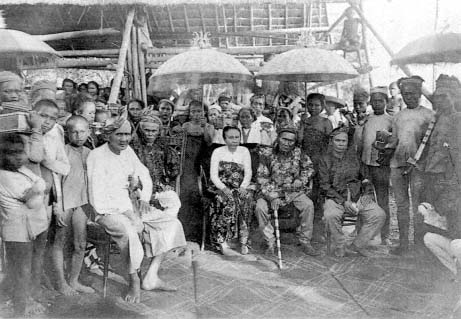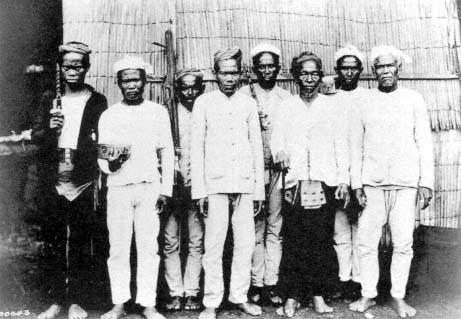Datu Piang
The first and most influential of the colonial datus of Cotabato was Datu Piang. According to the hagiographic biography of Piang contained in the 1952 Cotabato Guidebook (Millan 1952), he was born circa 1850, the son of a Chinese trader from Amoy named Tuya Tan and a Magindanaon mother. Datu Adil relates the following story about the birth and boyhood of Datu Piang: "The trader Tan came to Dulawan [the capital of the Buayan Sultanate] selling China goods. He presented silks and perfumes to Datu Utu and they became friends. Datu Utu gave one of his concubines to Tan and called a pandita [religious practitioner] to marry them. The girl became pregnant but Tan went off trading and never returned. The child that was born was unique—it had fair skin, so it was believed he was the child of Tan. He was named Piang and was an industrious child. He cultivated the
friendship of the officers of the Spanish garrison at Bakat by running errands for them." Throughout his life Piang was unashamedly aware that he had little or no noble blood in his veins. The 1952 biography notes that he never used the honorific "datu," instead calling himself "Ama ni Mingka" (or its shortened form "Amai Mingka"), or father of Mingka, the name by which he is still best known among the Magindanaon.[6]
Piang became a fast-rising protégé of Datu Utu, the Sultan of Buayan, who made him his "Minister of Lands" (Ileto 1971, 63). By 1890, however, the Spanish tactic of establishing forts in Cotabato to dissolve local lines of communication had proved successful and Datu Utu's inged was encircled, cutting him off from all sources of slaves and firearms (Ileto 1971). Piang as well as other of his lieutenants broke with Datu Utu when he was no longer able to provide them with firearms (Ileto 1971). Oral tradition relates that Utu's other followers deserted him in favor of Datu Piang because they could no longer tolerate his cruelty (see also Millan 1952). Piang very quickly replaced Datu Utu as the most powerful datu in the upper valley by forming an impressive alliance that included Utu's most forceful former confederates. Utu retired downriver to "spend his last years under Spanish protection" (Beckett 1982, 399).
Piang also quickly allied himself with Spain and sought the goodwill of Spanish authorities. His turugan (palace or stronghold; literally "sleeping place") was a short distance from the new Spanish fort at Reina Regente (just south of present-day Datu Piang). The fort provided him a shield from his Magindanaon enemies while he supplied its garrison with foodstuffs in exchange for cash (Ileto 1971; Beckett 1982). Equally important were Datu Piang's downriver ties in Cotabato town, particularly with Chinese traders. Beckett cites a 1901 American dispatch reporting 204 Chinese in the town of Cotabato, primarily engaged in the export of rice, beeswax, coffee, almaciga, and gutta-percha, the aggregate value of which was estimated at 150,000 Mexican dollars (1982, 402). Most of these products originated in upriver areas under the command of Piang, who apparently controlled both their production or collection as well as the terms of their export via Chinese merchants. Another contemporary American chronicler, Najeeb Saleeby (see below) reported that by "the time of the Spanish evacuation [Piang] had become the richest Moro in Mindanao and the most influential chief in the island" (Saleeby 1908, 292).

3.
Datu Utu (seated center) with his wife, Rajah Putri, and retinue, circa 1890.
This photograph was probably taken on the occasion of the elderly Utu's move
downriver to live under Spanish protection in Cotabato town in 1890. Datu Utu's
severely crossed eyes may be the source for some of the stories told about
his fierce appearance. Courtesy of the U.S. National Archives.
Piang's loyalty to Spain lasted just as long as the physical presence of Spanish soldiers. With the Spanish evacuation of Cotabato in 1899, the men of Piang and his allies sacked Cotabato town, and a number of Christian Filipinos were killed or forced to flee. The Cotabato Chinese remained under Piang's protection and were spared. Ileto (1971) reports that Piang also declared himself Sultan of Mindanao in spite of his lack of genealogical precedent. Whether or not Piang made such a formal declaration it appears clear that at that point he was the effective ruler of Cotabato.
Piang's independent leadership of Cotabato lasted only a few months. The American occupying forces arrived in late 1899, and within a short time Piang was on his way to becoming—as described in his 1952 biography—"America's Great Friend" (Millan 1952, 292). One of the early significant services rendered by Piang to the
Americans was his assistance in eliminating the threat to American policies posed by his son-in-law, Datu Ali, the highborn nephew of Datu Utu. Between 1903 and 1905, Datu Ali led the only large-scale armed resistance to American rule in Cotabato.[7] Ali commanded a large number of armed followers, was skilled in guerrilla warfare, and, as heir apparent to the sultanate of Buayan, seemed capable of mobilizing the entire upper valley in revolt against the Americans. Datu Piang provided the intelligence that allowed Ali, stricken with malaria, to be surprised and slain by American soldiers. Oral tradition asserts that the Americans obtained Piang's assistance only by torturing him. Nevertheless, as Beckett points out, "Ali's death saw [Piang] on the winning side, the authorities in his debt, and his aristocratic rival out of the way" (Beckett 1982, 401).
By 1908, Cotabato was reported to be the most peaceful district in the Muslim Philippines, due in large part to the influence of Piang (Mastura 1979; Beckett 1982). Piang was also exceptionally responsive to American programs. The great majority of high-ranking datus were deeply distrustful of Western education and, when told they must have their sons educated at colonial schools, sent slaves in their place.[8] Piang, however, sent his own sons all the way to Manila to study (Beckett 1982). He also supported the settlement of Christian immigrants from northern islands and the establishment of agricultural colonies, which began in 1913 (Thomas 1971).
In 1915, with the end of the tribal ward system and the establishment of colonial administration in the South similar to that in the rest of the colony, Datu Piang was appointed as the only Muslim provincial board member for what was now the province of Cotabato. In the following year he was appointed to the National Assembly by the American governor general. These two positions had few formal responsibilities and conferred virtually no legal authority. They were, however, emblems of official American recognition of Piang as the preeminent leader of Cotabato Muslims as well as incentives to assure his continued cooperation with the now expressly stated colonial policy of integrating Muslims into the national political structure.
The political potency achieved by Datu Piang through his association with the armed might of the Americans, and before them the Spaniards, was symbolized by Magindanaons in their representations of Piang's index finger as supernaturally efficacious. According to Datu Adil: "It is said that the index finger of Piang was magical. If he pointed it and said 'enemigo,' people were killed; if he said 'amigo'

4.
Datu Piang (front row, second from right, with cane) and his officials and attendants,
circa 1914. Despite his quite considerable wealth and power, Datu Piang is reported always
to have dressed quite simply, in contrast to the more elaborate attire worn by most
Magindanaon datus of the period (see, for example, the dress of Datu Utu in Figure 1). The
datu's attendants include two kris bearers, a kampilan (long sword) bearer (second from left,
rear), and two men carrying brass containers for betel nut. Courtesy of the U.S. National Archives.
they were saved. He was feared because of that."[9] Piang's economic achievements under American rule were comparably impressive. He continued his lucrative connections in the Chinese-controlled export trade while expanding into rice-milling and lumber (Beckett 1982). He also maintained his base in the upper valley and by 1926 was reported to have accumulated massive wealth that included "42,000 coconut trees (they are good for $1 per tree each year) thousands of carabao [water buffalo] [and] thousands of hectares of rice land . . . to say nothing of the tithe paid him by his loyal subjects."[10]
Evidence from various sources suggests that Datu Piang was an exceptionally shrewd and independent-minded collaborator, ever mindful of the opportunities for personal gain made available through his
gatekeeper role. A 1906 letter from the American governor of the Moro Province to the district governor of Cotabato expresses anger and exasperation at Datu Piang's attempt to collect rent from the superintendent of schools for the use of a school building that Piang had constructed in his inged at Dulawan. The letter states in part: "You will tell him, furthermore, that if he and his people cheerfully paid the cedula [head tax] and other taxes due from them to the government, we would ask from him no such assistance, but that in view of their dereliction in this and in view of the further reasons set forth above, it is believed to be a fair proposition that he should give the free use of this building for school purposes" (Bliss to the district governor of Cotabato, August 14, 1906, quoted in Gowing 1983, 198). Datu Adil tells of a road that Datu Piang contracted to build for the Americans across a swampy tract in the upper valley for twenty thousand pesos: "Piang called on his [client] datus to assist him. They arrived with their followers and enough food to feed them. The road took more than two months to build but Piang never shared any of the money he received with his datus."
These stories illustrate how collaborating datus were often able, relying on traditional power relations, to call out corvée labor in order to avail themselves of new opportunities to enrich themselves during the early colonial period. Datu Piang seems to have been more successful at this strategy than any of his contemporaries. He died in 1933 at the approximate age of eighty-four (Millan 1952). Five of his sons became either politicians or professionals.
In 1918, Piang's niece, Bai Bagungan of Buluan, became the first female municipal district president (a colonial-era post comparable to mayor) in the Philippines. Though her late husband preceded her in the post, she did not automatically succeed him. Shortly after her husband's death she married a younger man of much lower status who had served in his household. Datu Piang was furious that he had not been consulted in the matter and ordered the couple confined in the provincial jail to force Bagungan to change her mind. She remained steadfast and Piang eventually gave way and sanctioned the marriage. When the datu appointed by Piang to fill the municipal post resigned, Bai Bagungan was appointed municipal district president after receiving an overwhelming vote of confidence from the male electors of the district. Bai Bagungan was an active official who, in the words of Philippine Governor General Cameron Forbes, "became a vigorous partisan of public schools, especially for girls, and in other ways a
valuable influence in the extension of American administration in Mindanao" (Forbes 1928).[11]